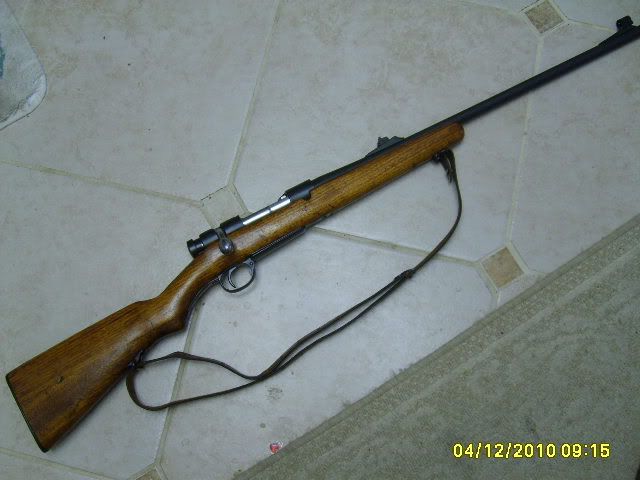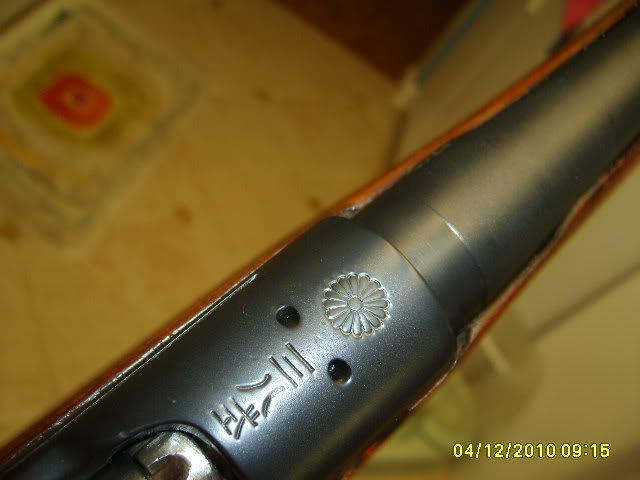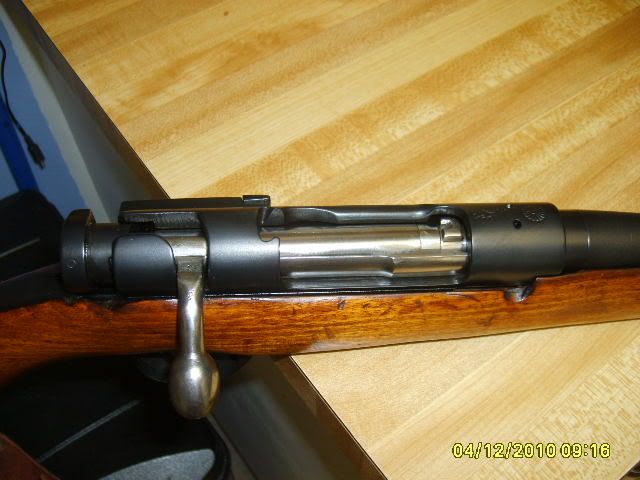

 The Accurate Reloading Forums
The Accurate Reloading Forums  THE ACCURATE RELOADING.COM FORUMS
THE ACCURATE RELOADING.COM FORUMS  Rifles
Rifles  Sporterized Military Rifles
Sporterized Military Rifles  Arisaka, not mine
Arisaka, not mineGo  | New  | Find  | Notify  | Tools  | Reply  |  |
| One of Us |
Food for thought. Found these pics on the HD, maybe from an auction, maybe from here. Like the way the stock&metal was handled.    | ||
|
| one of us |
Good soild truck gun.  Doug Humbarger NRA Life member Tonkin Gulf Yacht Club 72'73. Yankee Station Try to look unimportant. Your enemy might be low on ammo. | |||
|
| One of Us |
My thought exactly. | |||
|
| one of us |
I have not seen many of those rifle with the "flower" still intact. That rifle is still in very good shape. DOUBLE RIFLE SHOOTERS SOCIETY | |||
|
| One of Us |
Nice Arisaka, a type 38 action I guess and its been rebarreled too. Have a couple of type 38s, each rechambered to 257R, but still has the original 6.5 barrel, so they're 6.5x257Rs. Have been toying with idea of rebarreling one of them to perhaps a 250 Savage. Unfortunately, neither of gents in my area that I use for gunsmithing will work on an Arisaka. | |||
|
| One of Us |
That's a nice job by someone. Most the ones that still have the chrysanthemum were more then likely vet bring backs before the war ended I would think. So in that respect I wouldn't think there would be as many of them. I thought the whole idea of removing it was kind of crazy, I don't that has happen anywhere else has it? | |||
|
| One of Us |
As I understand it, the Mum removal was intended as a humiliation to conquered Imperial Japan. | |||
|
| One of Us |
Removing the mum was a face-saving gesture by/for the Japanese, as it is the national symbol (as I understand it). I've seen intact mums on maybe 25% of the Arisakas I've seen. Some Argentine '91's have the receiver scrubbed, too, I've noticed. | |||
|
| One of Us |
Still foolish in my opinion. Historians still argue over whether it was Gen McArthur's ideal or the Japanese. Wonder why the Swastika's weren't defaced off all the Nazi guns? | |||
|
| One of Us |
The chrysanthemum was the Japanese Imperial seal. ______________________ Hunting: I'd kill to participate. | |||
|
| One of Us |
What bottom metal is on this rifle? Doesn't look like type 38 or 99. | |||
|
| One of Us |
If you blow the picture up you can see that's the milled Type 38 with the magazine floor plate release button in the trigger bow. | |||
|
| One of Us |
I've seen the type 38 stamped, didn't know about these- thanks. | |||
|
| One of Us |
The chrysanthemum (sp?) showed the rifle was the property of the Emporer on loan to the soldier who used it on his behalf. The Japanese were allowed by McArthur to remove it as part of the surrender terms. Not all went through that processing. Guns captured during the war and taken home as war trophies by individual soldiers before the surrender invariably have the "mums" intact. So do many guns taken from units pread around the world after the surrender where those units did not have the time or equipment to remove the mums before they had to turn over their arms. The great majority of the rifles without their mums were surrendered IN Japan to the occupation forces. | |||
|
| One of Us |
Interesting on the "loan" aspect of the mum. -a high school friend back in that day had one with the mum and dust cover intact. In fact he put his coin into a collection of NRA excellent examples of military rifles. I could never stand the things- until too late in life I'd like a truck build on several "surplus" rifles, an Arisaka included. | |||
|
| One of Us |
All the type 38's I've seen were milled. All the type 99's (7.7 Jap) were stamped. I'm wondering what you saw and if somehow someone put a 7.7 trigger guard on a type 38. I don't believe they had a last ditch type 38, but they did the type 99. | |||
|
| One of Us |
THE MISSING MUM MYSTERY By Doss White The 16-pedal chrysanthemum is the Imperial seal of Japan. It was stamped on the barrel or the receiver of all Muratas and Arisakas. A large number of rifles brought home by veterans after WW II had the chrysanthemum (mum) removed or defaced. This article examines what we know, 50 years + after the end of the Pacific conflict, of the removal/defacement of this seal. From the first millennium through the end of World War II, the Japanese Emperor was believed by the majority of the Japanese people to be Divine, a direct descendant of the Sun Goddess. This belief is discussed by Ruth Benedict, author of "The Chrysanthemum and the Sword." In her book she quotes a Japanese POW when asked about the relationship between the Emperor and Japan, "Japan without the Emperor is not Japan. Japan without the Emperor cannot be imagined. The Japanese Emperor is the symbol of the Japanese people, the center of their religious lives. He is a super-religious object." (1) The Emperor was such a spiritual being that even the symbol of his family deserved reverence. In the biography of Ellis M. Zacharias, a Washington D. C. dinner party with Japanese guests is described. "Zach had been talking to Commander Jo ... The two were lounging in easy chairs beside a coffee table on which there was a handsome cigarette box decorated with the crest of the Imperial Royal Family. The crest consists of fourteen chrysanthemum petals arranged in a circle, the symbol of the Rising Sun. Suddenly, the Commander sat as if transfixed counting the number of petals. Then he sat up suddenly and made a deep bow to the box. " (2) A well-educated Japanese naval officer bowing to a box! The Emperor was God to the Japanese people and to die in the service of God was the supreme act an individual could undertake. To die for the Emperor was to become a young god. It was with this belief that young men could crash their planes into the decks of enemy ships. And with this feeling/belief for the Emperor and for that which represents him, i.e., HIS crest, it is understandable how it could be an insult to "HIM"' to allow equipment stamped with "HIS" crest to fall into the hands of the enemy. A believer in any religion knows the unpardonable sin of insulting their God! The above is an explanation of why the sixteen-petal chrysanthemum the symbol of the divine Japanese emperor, was removed from equipment (rifles) before delivering it into the hands of the "namban" ('southern barbarians' as Anglos were termed.) The actual act of mum removal has been documented. The following is part of a letter sent to Mike and Dan Larkin (CA) by a former pilot on the carrier Intrepid. "After a period of time it was announced ... that Japanese rifles were going to be distributed to anyone who wanted one for their collection. I remember seeing Japanese civilians using triangular shaped files to file a mark cross- wise to the barrel and defacing the Cherry Blossom symbol. We were told that this was the only way that the Japanese had agreed to surrender the rifles to the United States and then to be used as souvenirs of war. I was told that they believed this disfiguring of the symbol would destroy any special religious or power specially provided by the Gods of War. Every rifle which was disbursed aboard the carrier had to be defaced in this manner. The bayonets which went with the rifles had a mark on them also, but I believe this mark was merely the armament mark signifying where the bayonet was made, but these marks were not disfigured. There were many rifles taken aboard the carrier and distributed to the crew. I could not make any estimate as to how many were distributed, but do remember many small boat loads of them coming to the Carrier. The rifles were taken from wooden crates, marked by the files, then put back into the crates and taken to the carrier in this same crate. I would estimate this happened in late October or early November of 1945." (3) There are other accounts of Japanese civilians filing the mum from rifles at dockside. Many theories have been put forth to explain the reason behind the mass rifle crest removal that took place in the fourth quarter of 1945. One that has been spread over the years is that MacArthur ordered it done as an "insult" to a vanished foe, i.e. Hirohito, and as retribution for his (MacArthur's) defeat in the Philippines. Documentation exists which notes that MacArthur had no plans to debase the Emperor. In American Caesar , MacArthur is quoted as stating that he had no intention of humiliating Hirohito and MacArthur refused to demand an audience with him. When such a meeting was requested by the Japanese, he met with the Emperor in the Embassy rather than his office. It is extremely doubtful that the General, who went to great pains to protect the Emperor from embarrassment and humiliation, would debase his position by ordering his crest removed from captured weapons to be handed out to Allied servicemen on their return to their homes. There is one report from a former Japanese serviceman of the Japanese removing the crest on rifles before turning them over to the enemy. This was part of an answer to a question in BANZAI concerning a brass star on a field cap. "Question 1 - The field cap never had a brass star. It was very common practice when Japanese soldiers surrendered they removed "star" from cap, removed tabs from tunic, ground mum on rifle. I think someone put the brass star on your field cap. Original cloth star on it was removed." (4) In a past BANZAI issue Gary Nila reported on a Great Western show where he and Ken Radman met a Japanese gentleman who was a former WW II guard at a Manchurian airfield. At the time of the surrender, he and other troops were told to remove the mums from all rifles. The above would explain a few ground rifles, but since few Japanese surrendered it does not explain who mandated the grinding of a majority of rifles. It has been the writer's belief for several years that the Japanese, at some point in the surrender negotiations, requested that they be allowed to remove the Imperial crest from surrendered rifles. This theory is strengthened by a paragraph reportedly from a German publication. "All rifle production stopped when Japan surrendered in August 1945. American occupation forces destroyed all production tools. The terms of surrender required the Japanese to disarm their forces and deliver all weapons at times and places prescribed by commanders of the occupation forces. During collection of arms under this directive, the Japanese requested permission from Allied Headquarters to be allowed to remove the imperial Japanese seal from all rifles before they were turned over to occupation forces. Permission was granted and the crests were -around off all surrendered rifles. (Underlining added) The only rifles with the crests intact were those captured in combat zones." (5) To date, no written orders mandating mum removal have surfaced. There are plenty of cases documenting the U.S. military adhering strictly to the mum removal policy. The father of a friend, Damon Mills, was in the Occupation and sent home a case of five arsenal-new rifles with untouched crests. When the crate arrived home one rifle was missing, and the other four had been ground. (6) In this case it is obvious that the U. S. military postal authorities removed the crests and a rifle to boot! "... a published article tells of an American sailor who bought a Japanese rifle ... with full mum on the receiver. It was tagged and placed in the ship's locker until they reached port in the United States. At that time the rifle was returned to him BUT the mum had been ground" (7) Perhaps this is another case of work by the military postal authorities, this time on shipboard. Over the years, this writer has examined or owned a number of late Type 99 rifles, so late that they were manufactured with a hole in the butt for a rope sling rather than a metal swivel. Several still had the mums. The writer once owned two outstanding, arsenal-new T-38s, a long rifle and a carbine, that were brought back late in the occupation, both had full chrysanthemums. Why weren't these rifles ground? It is believed that the late rifles were stored in an out-of-the-way location and were not passed out as war booty until late in the occupation. By this time the mum removal orders were relaxed and a number of rifles were returned without having the crests defaced. As a postscript, it should be noted that a large number of the Arisakas imported from China had the crests ground. It is doubtful that MacArthur sent troops to China to grind mums. The crest removal was a Japanese act. Following the surrender the Japanese had ample time to remove the Imperial crest before herded into detention areas by the Allies. One of the ground weapons from China was a "Six Five Infantry Rifle" (65IR), a Type 38 copy made by a Chinese warlord. Instead of a chrysanthemum, the receiver was stamped with the Chinese characters for 'six', 'five', 'infantry' and 'rifle'. These characters were ground from the receiver. This suggests that the "65IR" was mixed with a group of T-38s and the troops, when told go 'grind' ground anything at hand! Apparently, in some cases the reverence for the Emperor's seal was greater than the order to destroy it. The writer once examined a 20'j' series Type 38 rifle that had a series of chisel-marks on the chamber top forward of the mum and several on the right side of the receiver in line with the chrysanthemum. The mum was untouched. In spite of orders some soldier could not bring himself to deface the Emperor's crest. It is interesting to note that most ground rifles were Type 99 and 38 units. It is rare to find the chrysanthemum on a Murata, T-30 or 35 ground. Apparently the order to remove the crest before 'souveniring' the rifle specified the 99 and 38 or "currently issued" rifles. When the others were ground it was by mistake. In summary, it is this writer's belief that MacArthur and/or the Allied commanders had absolutely nothing to do with the removal of the sixteen-petal chrysanthemum from the surrendered rifles, other than to agree to Japanese requests that the crest be removed before the rifles were turned over as souvenirs. It is possible that this was such a minor matter in the surrender terms that MacArthur was not consulted or informed on the decision to agree to the Japanese wishes on the matter of crest removal. The task of grinding was assigned to Japanese civilians and former military personnel. Apparently U. S. military postal authorities were informed that all rifles accompanying returning servicemen should have the crests ground from the receivers. Somewhere, there should be a paper trail documenting the orders to allow the crest removal prior to the issuance of the rifles to the Allied troops. REFERENCES (1) Ruth Benedict, The Chrysanthemum and the Sword, Houghton Mifflin Co., Boston, 1946, p.32. (2) Mira Wilhelm, The Man Who Watched the Rising Sun, Franklin Watts Inc., NY, NY, 1967, p.92. (3) Letter to Mike and Dan Larkin, from Chuck Darling, in BANZAI, Issue 25, April, 1984, p. 123. (4) Kazukiki Shikata, "Answers" in BANZAI, Issue 29, August 1984, p. 250. (5) Letter to Don Harper from Art Good, Jr. dated 8-29-82. "It's from a 1968 German publication." (6) Damon Mills, personal communication with writer. (7) James F. Coleman, Japanese Military Rifles, unpublished manuscript, 143p. (citation from page 33.) Mum stamp tool offered for sale in BANZAI in early 1980's.   | |||
|
| One of Us |
I'd have to say what I thought was type 38 was actually type 99. | |||
|
| One of Us |
As was posted earlier, "experts" still debate the removal of mums...why , when, and where. It is true that many mums were defaced to prevent shaming the Emporer when surrendering. But, where the rifles were captured in combat, that simply did not occur with any frequency to speak of. For one thing, Japanese soldiers simply almost never surrendered. They fought until dead or so wounded they couldn't fight. In neither instance did they deface the mums on their rifles, simply and solely ecause they couldn't do it when dead or grievously wounded. In the island campaigns, there were occasions where a garrison of 10,000 or more Japanese fought so bravely & tenaciously that it resulted in less than 20 prisoners being taken by allied forces when the fighting was finally done. McArthur did not cause the mums to be defaced, but he did allow the surrendering Japanese the opportunity to deface the mums on their rifles, so there would be no symbolic "capture" of the Emporer or his personal property...which all service rifles were considered to be. It never ceases to amaze me how history is distorted over time.... | |||
|
| Powered by Social Strata |
| Please Wait. Your request is being processed... |
|

Visit our on-line store for AR Memorabilia

